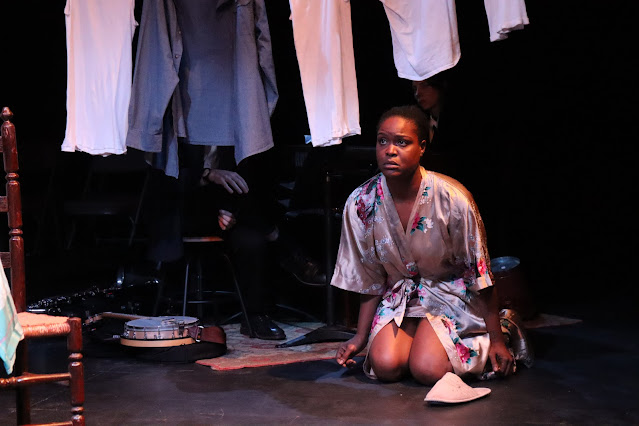Review: In "Katie's Tales," the Story of One is the Story of Many
Katie's Tales
Written and performed by Agnieszka Kazimierska
Directed by Mario Biagini
Presented at United Solo Theatre Festival
Theatre Row, 410 W 42nd St., Manhattan, NYC
November 11, 2023
 |
| Agnieszka Kazimierska in Katie's Tales. Photo by Nikita Chuntomov |
Kazimierska begins the show in Polish, and dons a headscarf intriguingly complemented by an academic robe, creating a sort of postmodern peasant costume. We learn that Katie's mother and father are worried about what Katie describes (still secondhand at this point) as her dying heart. The cause of her anguish is the departure of her beloved due to unspecified troubles in the world outside of the house and orchards belonging to Katie's family. War - a specific, 20th-century war - is directly suggested later, but the ambiguity as to precisely what historical upset bears away the object of Katie's potent love is of a piece with its sweeping transhistoricism and allows for fluid and flexible signification by Katie, her beloved, and their situation even amidst the historical markers of terms like lord and lady. Katie, in other words, always also represents Katies, as her beloved represents not only beloveds but also types of love.
 |
| Agnieszka Kazimierska in Katie's Tales. Photo by Nikita Chuntomov |
White Katie, in her simple white dress, remains the center of Katie's Tales, Kazimierska conjures multiple characters over the course of the hour-long show, from servant Mary to a drunk neighbor who makes a largely humorous appearance to a sadistic (male) invader in a standout sequence that replaces humor with a striking and memorable representation of the commandeering of (women's) bodily autonomy. Kazimierska's use of movement is no less expressive in such sequences than it is during the songs, performed in Polish, that are interspersed throughout the production. A singer with a rich, powerful delivery, Kazimierska skillfully uses her voice as an instrument even when not singing, whether delivering the sometimes poetic, even almost incantatory dialogue or, at one point, delivering a more than passable imitation of a horse. One of the overarching questions that all of this builds to is why humanity continues to go on hurting itself, destroying its own sense of belonging - a question with too many obvious current applications - and although there are requests for mercy and peace, the show's ending at best ambiguously banishes the (sorts of) trouble which Katie has endured. On the way to this ending, Katie's Tales produces in enthralling microcosm the experiences of the savage and the sublime by generations of women.
-John R. Ziegler and Leah Richards



Comments
Post a Comment